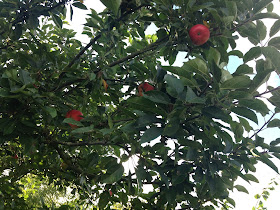In late August, I thought the apples were ripening later than last year on my allotment.
I was right. According to English Apples and Pears, the fruit growers association, the apple season began on Tuesday, two weeks late.Apparently, it's due to the late flowering of the apple trees after the cold weather in Spring .
Well, I kept looking at my apple trees, Three weeks ago, they still weren't ready despite a vivid rosiness on the apples of one tree, but within a few days they started falling..
Of course , the juiciest have stayed at the top of the tree...but that's not a problem now as I have a trusty helper in the form of this apple picker from Burgeon and Ball. I bought it at the end of last Autumn after not being able to reach so many apples.(Other apple pickers are available!)
I've been picking baskets and baskets of fruit.
The cooking apples aren't ready yet, but I'll be ready for them this year. Apple crumble and apple cakes ago go!
That's the beauty of an apple tree, it's a gift that just keeps on giving pounds and pounds of fruit.
Meanwhile, I hear that the total commercial crop of eating apples will reach over 150,000 tonnes, and they're in the shops now. There's nothing like the taste of an English apple........



















